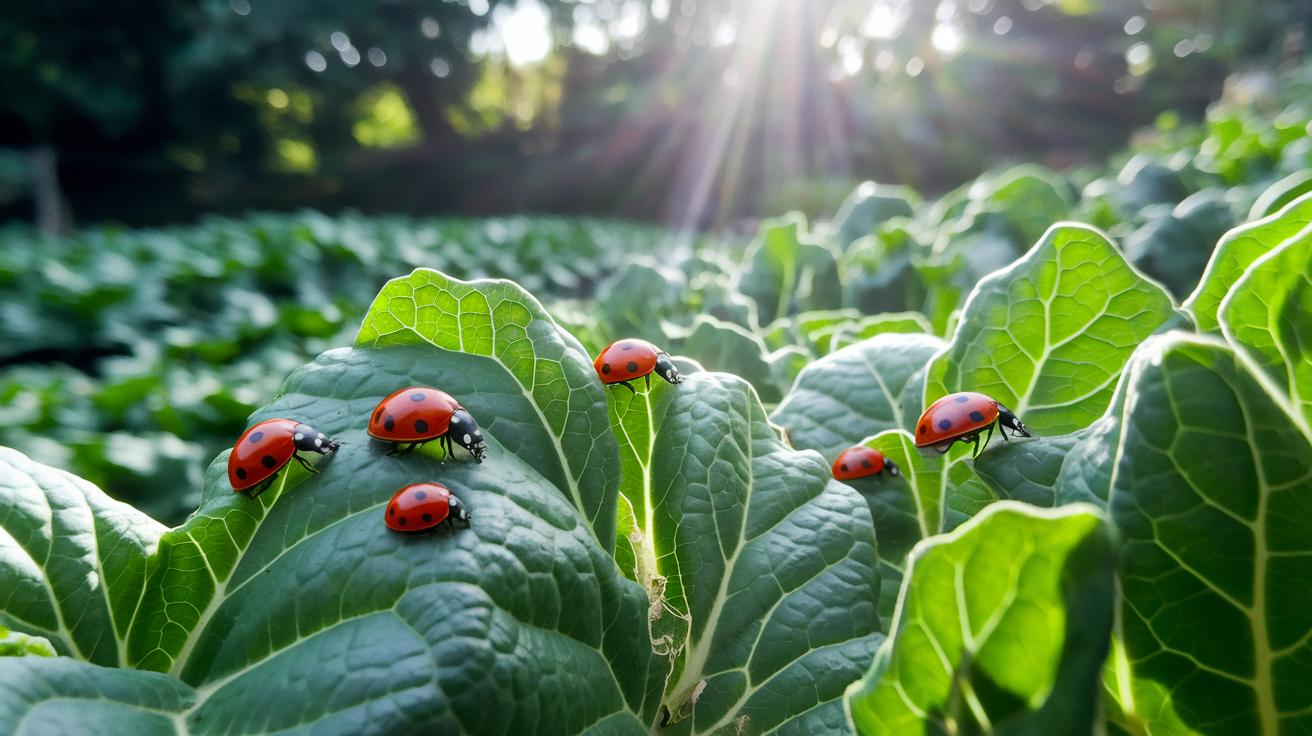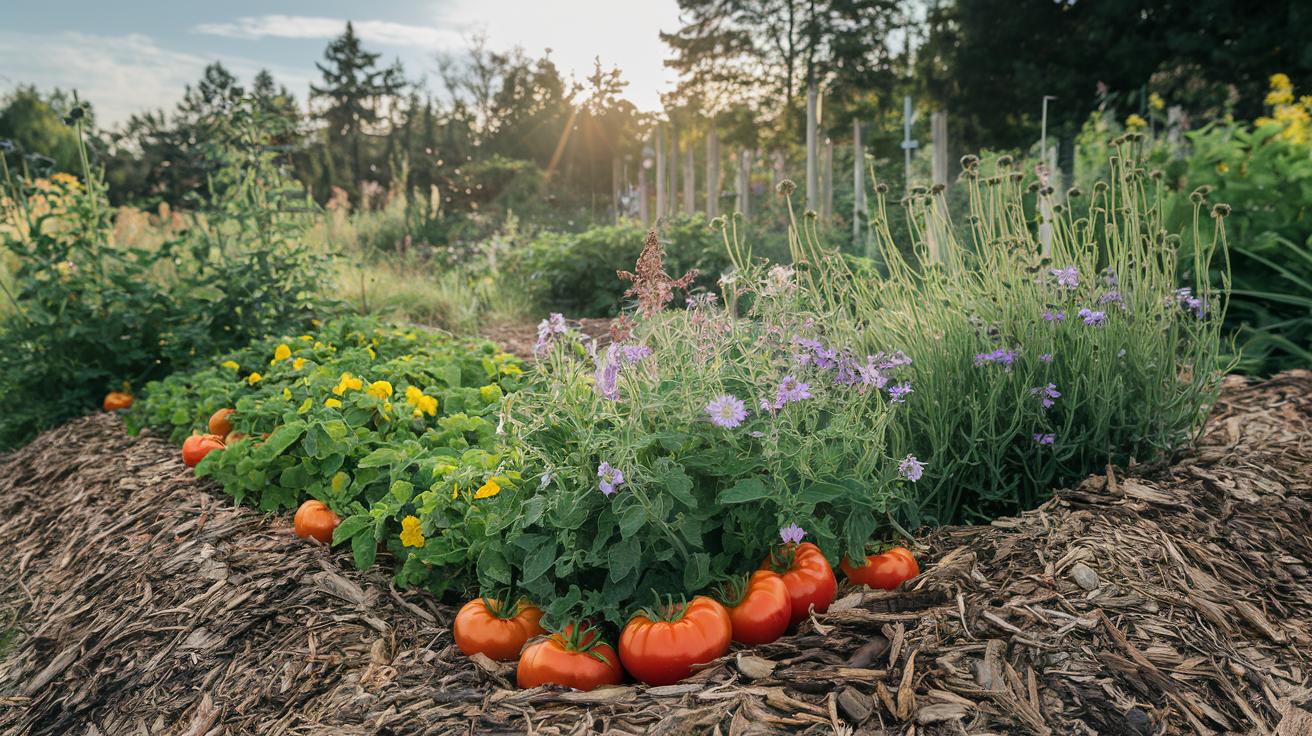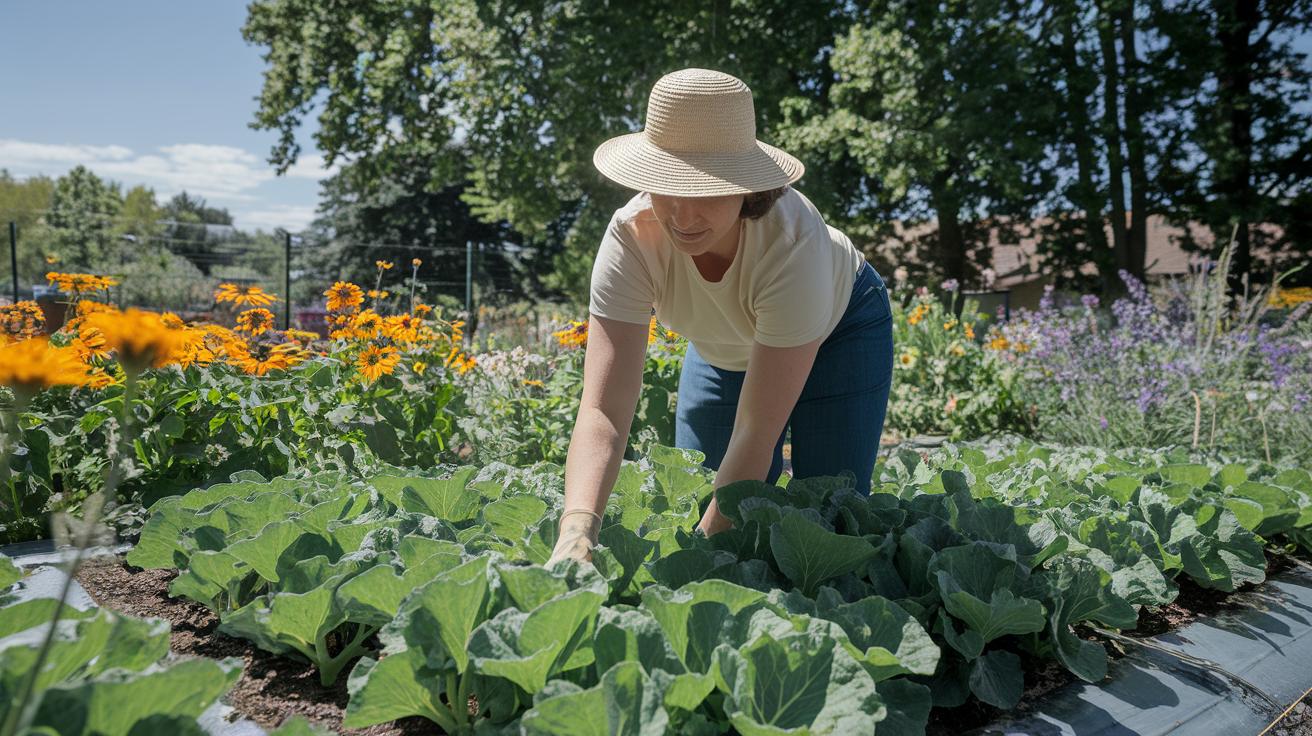Organic Pest Control For Vegetable Gardens: Powerful Tips
Have you ever woken up to find your lettuce leaves torn to shreds? Those caterpillars (the fuzzy stage before a butterfly) can turn your salad patch into a buffet overnight.
And you thought the only fix was spraying harsh chemicals, right?
But here’s the thing. You don’t need toxic sprays to protect your veggies. This simple four-step plan will have your garden covered.
First, scout your plants each morning to catch pests (unwanted plant-eating bugs) early. Next, plant bright flowers that confuse hungry caterpillars.
By the way, I once planted zinnias here, but marigolds won. Then invite nature’s helpers. Ladybugs (bright red beetles) love to munch aphids (tiny plant-sucking bugs).
Finally, keep your garden tidy by clearing away debris where pests like to hide.
By following these easy tricks, you’ll keep pests at bay and enjoy a big, healthy harvest. No harsh chemicals in sight.
Happy gardening!
Complete Organic Pest Control Framework for Vegetable Gardens
Hey there. Want to keep bugs from munching on your veggies? Try this four-step plan for all-natural pest control.
Step 1: Prevention
Rotate plant families (groups like beans, squash, tomatoes) each year to starve soil pests. Then mix in flowers and herbs to confuse invaders. Clean your shovel, gloves and seed trays to knock out hidden eggs. By the way, last spring I forgot this and got swarmed by hornworms. Oops.
Step 2: Monitoring
Spend a few minutes each week checking under leaves and along stems. Look for tiny holes, brown spots or sticky residue. It’s a bug treasure hunt. Note what you find right away so you can act fast.
Step 3: Intervention
Cover young plants with row covers (light cloth tents) before bugs arrive. Set sticky or pheromone traps to reel in pests. Release a handful of ladybugs or ground beetles. They love munching on aphids. Then whip up a garlic-chili spray (blend garlic, chili flakes and a bit of oil) and mist your plants.
Step 4: Evaluation
Count the pests you find. Ten aphids per leaf or three caterpillars per plant is your red line. Write down which methods worked and which didn’t. Then tweak your timing or tools next season.
That’s it. You now have a routine to catch bugs early and keep your harvest healthy. Stay tuned for tips on companion planting and simple barriers to guard baby sprouts.
Companion Planting and Cultural Controls in Organic Pest Control

Mixing cheerful blossoms, fragrant herbs, and tasty veggies is like setting up a secret code that bugs can’t crack. You’ll fool pests and help your garden stay strong and healthy.
- Plant marigolds next to tomatoes. Those sunny orange flowers chase off nematodes (tiny, worm-like pests that attack roots) and shoo away whiteflies.
- Tuck nasturtiums by cabbage and broccoli. They act as trap crops (pest magnets) for aphids, so your brassicas stay munch-free.
- Sneak basil in beside peppers. The herby scent deters thrips (small, slender insects) and buzzing flies.
- Line your bed edges with garlic cloves. The sharp smell keeps slugs and caterpillars wandering elsewhere.
And don’t forget to rotate plant families each year. Swap out Solanaceae (nightshade family like tomatoes and peppers) for Brassicaceae (mustard family like kale and cabbage). That starves out pests hiding in the soil over winter.
Succession gardening, planting quick crops every few weeks, helps too. Sow lettuce or radish seeds every 3–4 weeks. Hungry bugs can’t settle in when your menu keeps changing.
Give your plants elbow room. Aim for 18 to 24 inches between each one (about one and a half school rulers). That lets air swirl around the leaves and cuts down on spider mites and fungal spores (microscopic bits that spread disease).
Water at the base in the early morning so roots get a good drink. Wet leaves at midday invite mildew and other fungal problems. Trust me, your garden will thank you.
If you can, pick veggie varieties bred to shrug off pests, like heirloom peppers that laugh at leaf miners. Mix diversity, rotation, spacing, and smart watering into your routine. You’ll build a cultural fortress around your plants, and they’ll reward you with sturdier stems and fewer hungry visitors.
Mechanical and Physical Pest Control Methods for Vegetable Gardens
-
For row covers (light fabric draped over plant rows to keep bugs out), sticky cards (bright yellow cards that trap flying insects), and pheromone traps (devices that lure pests with special insect scents), see Step 3: Intervention.
-
Diatomaceous earth dusting (DE: fine, crunchy powder made from fossilized shells)
I like to head out at dawn when the garden’s still damp. Then I dust a thin band of food-grade DE around each stem base. A soft brush helps spread it evenly. Wait until the morning dew is still wet so the powder sticks. Oops, I once skipped this and the rain washed it away, lesson learned. -
Hand-picking pests
Have you ever found a slug on cool, damp leaves? I check my plants at dawn or dusk each day. Slip on gloves and grab a small bucket or a jar of soapy water (water with a drop of soap). Lift the leaves carefully to spot eggs tucked underneath. Pinch or brush each pest off into your container. Now I keep tweezers handy for the slimy ones. -
Reflective mulch placement
Think of reflective mulch as shiny film you lay under young plants before transplanting. Overlap the edges by about 2-3 inches and tuck them under soil so the wind can’t lift them. Cut a little circle around each stem to let air flow and keep rot away. That bright ground cover bounces light up to confuse aphids and thrips. You’ll see about half as many of them landing on your veggies.
Biological Control Agents in Organic Pest Management for Vegetable Gardens

Think of your garden as a little town with friendly bug patrols. They roam the tomato vines and pepper leaves looking for trouble, and they help your veggies grow strong.
Ladybugs (small round beetles) can munch up to 60 aphids (tiny plant-sucking insects) a day. For a 500 sq ft (about 46 m²) patch, release around 1,000 ladybugs in spring. Oops, I once let them arrive too late and aphids threw a party on my kale. Lesson learned.
Sweet alyssum (tiny white blooms) is like a dinner bell for lacewings (delicate green insects). Both grown-ups and babies hunt eggs and soft pests. Have you ever felt the soft tickle of lacewing wings? Just tuck a few alyssum clumps near seedlings and watch them move in.
Parasitic wasps sneak into caterpillar eggs and stop baby worms before they chew up your leaves. I wrap tomato stakes with cardboard strips so they find a safe spot to nest. At about 100,000 wasps per acre, you’ll feel good knowing they’ll slice the caterpillar threat in the bud. Back to your tomatoes now.
Beneficial nematodes (microscopic worms) hunt grubs and flea larvae underground. Mix 10 million Steinernema spp. in water and drizzle over 1,000 sq ft after dusk, when the soil is damp so they can wriggle deep. You might almost hear them squish through the dirt.
Ground beetles (flat shiny bugs) patrol under mulch and rocks at night, feasting on slugs and cutworms. Keep a little stone pile and leave some leaf litter at the edges for their cozy hideouts. Your garden’s going to thank you.
Bacillus thuringiensis var kurstaki (a natural bacteria spray) zaps hungry caterpillars – spray when you see chewed leaves. And spinosad (another bacterial spray) at 1 tsp per gallon blasts thrips, leafminers, and tiny worms without harming your helpful bugs.
For tight spots or pots, check out Natural Pest Control Methods for Container Gardens and start recruiting beneficial allies no matter your garden size.
DIY Organic Spray Recipes for Effective Pest Control in Vegetable Gardens
-
Neem oil spray: In a gallon of water, stir in 1 tablespoon of cold-pressed neem oil (squeezed from neem seeds) and 1 teaspoon of gentle liquid soap. Give it a good shake so the oil mixes in. Then mist your plants, focusing under the leaves. Do this every 7 to 10 days to help tackle aphids (tiny plant-sucking bugs) and spider mites (little web-spinning pests).
-
Insecticidal soap spray: Add 3 tablespoons of Castile soap (plant-based cleaning soap) to a gallon of water. Pour it into a clean spray bottle and soak the stems and the bottoms of the leaves. Reapply after it rains. It zaps whiteflies (small winged sap feeders) and other soft-bodied insects.
-
Garlic-chili pepper spray: Toss 3 smashed garlic cloves and 1 hot chili pepper into a quart of water. Blend until you see chunks. Let it sit for 12 to 24 hours, then strain through a fine cloth. Stir in 1 teaspoon of gentle soap per quart. Spray once a week to keep caterpillars (leaf-munching worms) and beetles away.
Grab a fine-mist sprayer so droplets hug each leaf. Have you ever seen tiny drops glistening on your greens? And always test on a couple of leaves. Wait 24 hours to spot any burn spots.
Spray early morning or at dusk when it’s cooler so your plants soak it up without getting scorched. Leftovers will last about a week in a sealed jug tucked in a cool, dark spot. By the way, I once spilled a bit and thought, “Oops, there goes my white tile,” but it wiped right off. Back to your recipes.
Need tips on setting up your garden first? See How to Start an Organic Vegetable Garden before you whip up these homemade sprays.
Seasonal Monitoring and Troubleshooting of Vegetable Garden Pests

Monitoring
When your garden wakes up you’ll want to peek under leaves. Use a visual count (just tally the bugs you see) or sticky traps (little cards coated with sticky stuff to catch insects) to spot pest peaks. By the way, rain can wash away eggs. So compare your counts week to week to catch any upward trends.
Evaluation
Once you’ve tracked those numbers, it’s time to judge if you need to act. Treat aphids and mites when you find 10 to 20 on a single leaf. And watch for 3 or 4 caterpillars chomping on the same plant.
Spotting pests early can save your summer harvest.
| Pest | Peak Season | Monitoring Method |
|---|---|---|
| Aphids | May to July | Visual counts, sticky cards |
| Whiteflies | June to August | Yellow sticky traps |
| Squash Vine Borer | Mid-June | Check stems for tiny holes and frass (insect droppings) |
| Slugs | Spring and Fall | Trap under boards or in beer cups |
Safety Practices and Product Recommendations for Chemical-Free Pest Control
Before you whip up a batch of neem spray or oil-based mix, slip on a pair of gloves and some safety glasses. It’s easy to get a splash on your skin or in your eyes. Test the spray on two or three fresh leaves first, then wait two days to watch for any brown spots or drooping. That small experiment keeps your veggies safe and sound.
And try not to spray when the sun is blazing overhead. Aim for early in the morning or as dusk settles. The leaves are cooler then, so they soak up the treatment without burning. A gentle breeze can help too, because the mist drifts onto bugs instead of your patio chairs.
So once you’ve got your homemade brew, keep it off the ground in a cool corner, around forty to seventy degrees Fahrenheit. Mark each bottle with the date and what’s inside. I usually check my labels every week. If it’s older than a month, I give it a toss and mix up a fresh batch. Oops, I guess that sounds like extra work, but trust me, it’s worth it.
Here are a few of my go-to, eco-friendly bug fighters:
- Safer Brand Neem Oil (neem extract that stops aphids, spider mites, and whiteflies)
- Bonide Captain Jack’s Deadbug Brew (contains spinosad, a natural bug killer for caterpillars and thrips)
- Surround WP kaolin clay (fine clay powder that coats and chases off whiteflies and spider mites)
These natural sprays fit right into your organic pest control plan, so you can dig in with confidence and get back to feeling warm soil between your fingers.
Sustainable Garden Practices to Prevent Vegetable Garden Pest Outbreaks

Fall’s the perfect time for a garden clean sweep. Have you ever felt the crunch of dried leaves underfoot? Raking up plant scraps and pulling weeds in late autumn stops sneaky pests from snuggling into your beds. That little bit of cleanup can cut next spring’s bug fuss in half.
When spring peeks around the corner, scatter a two-inch layer of finished compost (decayed organic matter that enriches soil) over your garden. The moist earth soaks it up. Those tiny helpers (beneficial microbes, little organisms that fight plant diseases) get busy boosting soil health.
Next, tuck three to four inches of organic mulch (a layer of straw or shredded leaves) around each plant. Mulch holds onto moisture, stops weed seeds from popping up, and hides hungry insects looking for a snack. I guess bugs don’t like surprises.
Now pick veggie varieties that fight back. Think about ‘Iron Lady’ tomatoes. They shrug off early blight and give you more time sipping lemonade instead of chasing worms.
Sprinkle native wildflowers like coneflower or black-eyed Susan through your rows. Pollinators buzz in for nectar. Predatory insects show up to dine on pests. Biodiversity at work!
Last step: test your soil pH (measure of acidity in soil) and aim for about 6.5. It’s the sweet spot for strong roots and fewer pest parties. Oops, I meant root parties.
With steady weeding, composting care, smart mulching, and balanced soil, you’ll spot fewer holes in your leaves. More time for morning coffee and the soft hum of bees around your sunflowers. Yes!
Final Words
We mapped a simple four-step IPM plan, prevention, monitoring, intervention, evaluation. You saw how to use companion planting and cultural tips to keep pests at bay. Then we dug into row covers, diatomaceous earth and handpicking for physical defense.
You met ladybugs, beneficial nematodes and microbial sprays. Next came DIY botanical recipes and a seasonal scouting calendar.
Finish with sustainable garden care and safe product picks. Ready for your own organic pest control for vegetable gardens with confidence and joy.
FAQ
What are the four phases of organic pest control in vegetable gardens?
The four phases of organic pest control are prevention (crop rotation, clean tools), monitoring (weekly scouting), intervention (barriers, biological agents, sprays) and evaluation (compare pests to action levels, adjust tactics).
How does crop rotation help in pest prevention?
Crop rotation helps by moving plant families each year so soil pests can’t build up. It breaks pest life cycles and keeps soil fresh.
Which companion plants repel common pests?
Companion plants repel pests by giving off scents or acting as traps. Marigolds chase away nematodes and whiteflies. Nasturtiums lure aphids. Basil foils thrips, and garlic deters slugs.
How do I use mechanical controls like row covers and traps?
Mechanical controls include row covers that block most worms and bugs before plants bloom. Sticky or pheromone traps catch flying pests. Handpick slugs and caterpillars daily.
What beneficial insects should I introduce for pest control?
Beneficial insects include ladybugs (eat aphids), lacewings (eat eggs), parasitic wasps (attack caterpillar eggs) and nematodes (target soil pests). Release at recommended rates in spring.
Can you share DIY organic spray recipes?
DIY sprays include: mix 1 tbsp neem oil plus 1 tsp mild soap per gallon for mites and aphids; a garlic-pepper brew steeped 12 hours for beetles; 3 tbsp soap per gallon for whiteflies.
How often should I scout my garden for pests?
Scout your garden twice a week. Record pest counts on each plant. Use counts against threshold levels to know when to treat.
What safety steps should I follow when using organic sprays?
Wear gloves and eye protection. Test sprays on a few leaves and wait two days. Apply sprays in cool morning or evening. Store bottles labeled at safe temperatures.
How can I prevent future pest outbreaks with sustainable practices?
Sustainable habits include removing debris and weeds in fall, adding compost each spring, mulching for moisture, planting pest-resistant varieties and mixing wildflowers to support predators.







